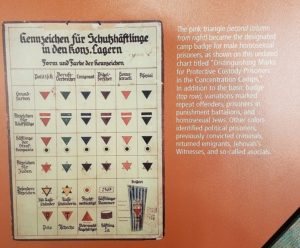How much do you know about the groups who experienced persecution at the hands of the Nazis?
The University of North Carolina Asheville is hosting the exhibit “Nazi Persecution of Homosexuals 1933-1945” produced by the United States Holocaust Memorial Museum from Feb. 12 to April 7 in the Ramsey Library at UNCA.
“The decision to bring the Nazi Persecution of Homosexuals was made before HB2 so we were particularly glad it was happening after that,” said Deborah Miles, Director of the Asheville Center for Diversity Education, about the significance of the exhibit. “Education is the way to build understanding on who transgender people are and how to interact with all members of the LGBTQ community with dignity and equality.”
Miles originally viewed the exhibit in the Breman Jewish Museum in Atlanta Georgia 10 years ago when she, had “only the faintest idea about this part of Nazi ideology and persecutions.” She wanted the exhibit to come to UNC Asheville ever since.
The exhibit is composed of a series of panels begging before 1933, prior to Nazi leadership, and ending with a panel titled “The Aftermath” The panels are arranged in chronological order, going through the legislature and events of the rise and fall of Germany’s National Socialist Party in relation to Germany’s homosexual population.
Each panel is composed of photographs, documents and works of art accompanied by a caption giving credit, if available, and context. The panels display a variety of police photos taken of men arrested under criminal law Paragraph 175 for “unnatural indecency” between men through 1933 to 1945.
However, there were acceptations to Paragraph 175. The United States Holocaust Memorial Museum published an article to go along with the exhibit which states that, “lesbians were not regarded as a threat to Nazi racial policies and were generally not targeted for persecution. Similarly, the Nazis generally did not target non-German homosexuals unless they were active with German partners.” The article can be read here.

“Nazi Persecution of Homosexuals 1933-1945”
The exhibit also displays Nazi propaganda posters, eugenics diagrams, and photos of Nazi leaders, such as SS chief Heinrich Himmler, directly involved with the persecution of the homosexual population along with the ideology that was used to justify the persecution.
At the final panels, there are photos of memorials dedicated to the 5,000 to 15,000 homosexual men who were sent to concentration camps, the estimated 50,000 who served prison sentences, and the unknown number who were institutionalized in mental hospitals.
“I’d like to bring an exhibit on The White Rose next year,” said Miles. “This is about a college resistance group during the Nazi time period.”
Other exhibits the CDE has created can be found here.
The United States Holocaust Memorial Museum website can be found here.



